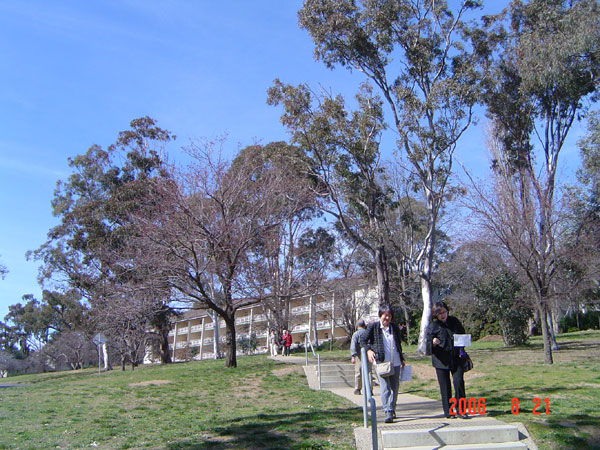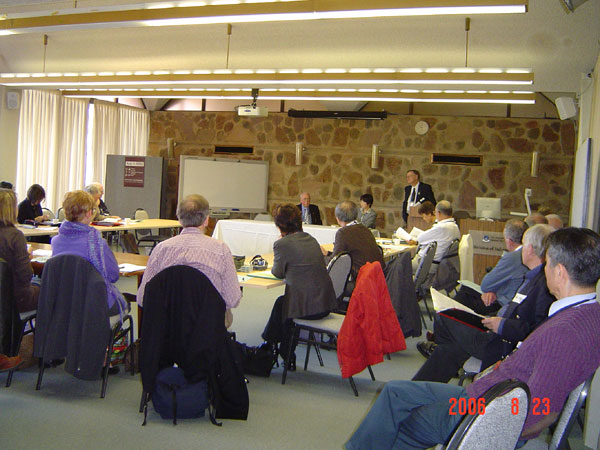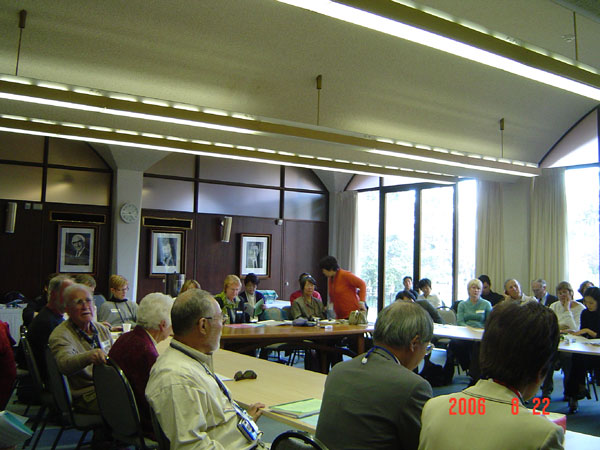| Seminars |
Seminar in Australia
Towards a Better Understanding
-Reflections on the Experiences of Australian Prisoners of War of the Japanese-
On August 22 and 23, 2006, a Seminar on the subject above was held at the Australian National University (ANU) under the auspices of the Division of Pacific and Asian History, Research of Pacific and Asian Studies of the said University and the POW Research Network Japan (POW-RNJ). There were about 100 participants in all, including 13 members of the POW-RNJ, Australian researchers, ex-POWs and their families, and others in the Seminar in two days.
Program
Outline of the Speeches
During the World War II, 22,000 Australians became the prisoners of war of the Japanese, and 8,000 died in their captivity. This figure was enormous for a country with a population of 7,000,000. Quite different from other allied countries that fought mainly in Europe, Australia deployed its armed forces directly against the Japanese; therefore, the Australian concern for their prisoners of war was especially great. Shortly after the war, this concern lessened as the time passed by. However, the interest in the ex-prisoners of war of the Japanese was revived in the 1980s, and has secured a significant place in national history. It has been talked about not as stories of great victory or battlefield heroes who have shown greatness by killing large numbers of the enemy, but as those virtues of senses of solidarity and fraternity under mistreatment and ordeals that Australians like to think they possess and that they want others to see in them.
Approximately 36,000 Allied POWs were transported from the Southeast Asian Areas to Japan, and were compelled to engage in hard labor under severe living conditions at 130 POW Camps throughout the country. Of the 36,000 POWs, 3,500 died before the war was ended. Mr. Fukubayashi reported the outline of the facility, food, clothing, labor, medical care, guards and punishment, and other matters related to the POW Camps. In the postwar so-called Class B and Class C war criminal trials, 475 of those who had been connected with the POWs were prosecuted, and charged with acts of violence, killing of escaped POWs, lack of medical care, insufficient food, embezzlement of the International Red Cross relief, etc. Of those who were found guilty, 28 were executed.
Dr. Richards talked about his experiences as a Medical Officer. He was captured during the Japanese invasion of Java Island. After the slave labor in the construction of the Burma-Thailand railway, he was sent to Japan aboard an "unmarked" Rakuyo-Maru, which was torpedoed by a US submarine, and went down to the bottom. Fortunately, he was rescued by a Japanese corvette, and was sent to Sakada POW Camp in Yamagata-ken. He says that the responsibilities of mistreatment of POWs are classified into three categories - guards and camp administration, local or regional commanders, and the Emperor, or the Imperial General Headquarter in Tokyo - however, the Emperor and many close to him were not charged with war crimes. There has never been an official apology, much less adequate compensation. He wishes that there will be a National apology and some form of recognition before he and the surviving ex-POWs join their departed comrades.
In January 1942, after the landing of the Japanese forces on New Britain Island, 18 Australian nurses were captured, and led fearful life being detained in a Mission on the island, and exposed to constant threat and violence. In July of the same year, they were transported to Japan, along with the Australian officers who had been stationed in Rabaul, aboard Naruto-Maru, and detained in a camp in Izumi-cho, Totsuka-ku via No. 2 Kanagawa Camp (Yacht Club) in Yokohama. They had to struggle with unaccustomed climate and living conditions, shortage on food and daily necessities. However, they encouraged each other and endured through all sorts of hardships with their wisdom, courage, and cooperative spirits, and all of them repatriated.
1)In the movie "Bridge on Kwai," the commando led by an American officer blows up the bridge across the Kwai River. This, however, is a fictitious timber bridge. In fact, both bridges across the Mae Khlaung River were destroyed by aerial bombings. Both the US Army Air Corps stationed in the inland China and the Royal Air Force in India employed the American-made B-24s in carrying out those aerial bombings. The B-24s responsible for the final destruction of the bridges were the RAF's.
2)After the war, Mr. Barrett voluntarily joined a team locating several thousands Allied POW remains scattered in numerous cemeteries along the Burma- Thailand railway. One of their tasks was to search for the remains and prepare the records; another was to recover the evidences that had been buried with their dead comrades to prove atrocities committed by the Japanese and Korean guards against the POWs. The search was conducted from 22 September to 10 October, and Mr. Nagase Takashi, who was an interpreter of Kempei-tai and familiar with the area, joined the search team.
Malay Peninsula Peace Cycle (MPPC) is a peace rally to travel by bicycle from Thailand to Singapore, visiting the old battlefields and making friends with the local people. It was begun in 1994, and the 6th rally was held in 2005. During this rally, Mr. Onogi and others succeeded in locating the accurate place where the Sonkurai Bridge, which was the true model in a book and movie entitled "The Bridge on the River Kwai," was, and discovered six concrete blocks used for the bridge. The location of this bridge is in the mountainous area close to the boarder of Thailand and Myanmar, crossing the River Song Khalia, which flows through Song Khalia village.
Approximately 375 members of the Royal Australian Air Force (RAAF) became prisoners of war of the Japanese, which represents a mere 1.6% of the 22,000 Australian prisoners of war. About 135 (one third) of them died in captivity from torture, execution and hard labor associated with the construction of Burma-Thailand railway. Dr. Moremon has been interviewing about 25 RAAF members who are still alive. Stories of the railway were horrible. The survivors suffered from trauma for many years after the war. According to him, they believe they would have died in Japan had the war not ended when it did.
Mr. Flowers was a member of the Australian Field Ambulance. After the fall of Singapore, he looked after the needs of battle causalities, and deficiency diseases at Changi POW Camp. Many were suffering from eye trouble, skin eruptions, beri beri, pellagra caused by malnutrition. In addition, the toll was taken by either malaria, or amoebic bacillary dysentery. He remembers he was much surprise to hear when one who had been back from the Thailand-Burma railway said, "Thank God, I'm home!" Comparing with there, things were much better off at Changi. He still wonders why didn't the Japanese treat them even a little better with foodstuffs and medical supplies? The Australians would have had a much better and capable work force. No wonder the Japanese didn't achieve their dream of the Great Southeast Asia Co-Prosperity Sphere.
About 300 Australian soldiers were detained in Naoetsu POW Camp (Joetsu-shi, Niigata-ken), and 60 of them died before the termination of the war. After the war, 15 men involved in the Naoetsu POW Camp incidents were found guilty of the mistreatment of the POWs, and eight of them were executed. Because of this, the local people never talked about POW issues. In 1978, a letter from an ex-POW was delivered to Joetsu-shi, which was an epoch making event to begin a civic movement by the people of Joetsu to hand down the history of the POW Camp to the next generation. In 1995, the Peace Memorial Park was open at the site where the Camp was, and the Statue of Peace and Friendship and two Cenotaphs for the deceased POWs and eight executed guards were erected. Since then, friendship interchanges between the ex-POWs and their families and the people of Joetsu-shi have been carried on.
Mr. McLachlan's grandfather was a former British soldier, who was captured by the Japanese in Dutch Timor. After being transferred to Java and Singapore, his grandfather was transported to Japan aboard Tokyo-Maru, and interned in the POW Camps in Mitsushima (Nagano-ken) and Kanose (Niigata-ken). His grandfather is over 90 years of age, and currently lives in NZ. Mr. McLachlan has interviewed his grandfather and over 100 ex-POW comrades of his grandfather's throughout the UK, Canada, the US, and Australia. What he has learned from the interviews - "Revenge is self-destructive;" "Human nature = survival," "The defeat learn more than victors" , etc.
* I trust that through the active discussions between the attendees in this two-day Seminar, it helped enhance our mutual understanding a little.
* In Japan, very unfortunately, little or no attention has been paid to the POW issues. Although the POW matters drew such a great attention in the War Tribunal, descriptions on the POWs and civilian internees in the official publications are almost none.
* In the Japanese Army, the role of the POW administration was considered lowly and, therefore, had limited authority. However, the war crime accusations by the Allies focused on the atrocities against the POWs, and many of those who had been related to the POW Camps were tried. They were confused by the severity of the accusations versus their responsibilities, and felt that the trial was unjust. For this reason, a lot of those who were found guilty shut their mouth. Particularly in a village where an executed person's bereaved family lived, people kept silence about the POW issues in consideration of the family. Furthermore, the War Tribunal materials were not made available to the public for so long a time that it hindered researches and studies on the POW issues.
* Recently, the Japanese Ministry of Foreign Affairs has begun releasing historical materials which had been kept in the Foreign Affairs Museum. At the National Library, the GHQ/SCAP related materials owned by the US National Archives could be read by microfilms. The materials of the US National Archives, the Australian War Museum, and National Archives have also been released, making it possible to study why the Japanese committed atrocities against the POWs during the Pacific War from the view points of both sides.
* Time heals all wounds, as an old saying goes. Ex-POWs finally broke the silence, and began talking about their bitter experiences after many years, and there have been small-scale interchanges with Japan. As is the case of our POW-RNJ, in Japan, a group tackling on the POW issues mainly by the postwar educated generations has made its appearance.
* The Japanese Army's policy on the POWs changed during the war. At the early stage of the war, although the Japanese Army captured a far greater number of POWs than they had expected, originally, there was no definite policy. It was as late as in May 1943 when the policy was established, which was based on a big propaganda that Japan had gained a victory over the white race, and the use of their man-power to help carry out the Japanese war efforts. For this reason, many POW Camps were established in the Japan proper and various places in the Southeast Areas, so-called "The Great Asian Co-Prosperity Sphere," and Korean and Taiwanese guards were posted.
* In the 1990s, former POWs and forced labors in Asia brought lawsuits asking for compensation and apology from Japan one after another. Thus related documents became indispensable for the lawsuits, without which they cannot win the cases. We, the members of the POW-RNJ, have been and will be continuing tackling on the task of interviewing the people concerned, and digging out the information/materials in Japan, which are needed for the lawsuits. Continued efforts on such activities by the Japanese citizens will help enhance a better understanding between Australia and Japan. At the same time, we would like to hand down our activities to the younger generations of high school students and school children, and others.

|

|
|
The AUN Campus |
Participants at the Seminar |

|

|
|
Scene of the Seminar |
Scene of the Seminar |